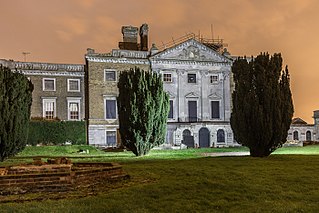Related Research Articles

Sir Gilbert Heathcote, 1st Baronet was an English merchant and Whig politician who sat in the English and British House of Commons between 1701 and 1733. He also served as the governor of the Bank of England and was Lord Mayor of London in 1711.

William Lowndes was an English Whig politician who sat in the English and British House of Commons from 1695 to 1724. He served as Secretary to the Treasury during the reigns of William III of England and Anne, Queen of Great Britain.

Sir William Dawes, 3rd Baronet was an English Anglican prelate who served as Bishop of Chester from 1708 to 1714 and then as Archbishop of York from 1714 to 1724. Politically he was a Hanoverian Tory, who favoured the Hanoverian Succession.
Sir David Dalrymple, 1st Baronet, of Hailes was a Scottish advocate and politician who sat in the Parliament of Scotland from 1698 to 1707 and in the British House of Commons from 1707 to 1721. He served as Lord Advocate, and eventually Auditor of the Exchequer in Scotland in 1720.

Sir William Strickland, 3rd Baronet of Boynton, Yorkshire was an English landowner and Whig politician who sat in the English and British House of Commons between 1689 and 1724. He was also a notable racehorse owner.
Sir Thomas Frankland, 2nd Baronet, of Thirkleby Hall in Yorkshire, was an English landowner and Whig politician who sat in the English and British House of Commons from 1685 to 1711. He was joint Postmaster General from 1691 to 1715.

Sir John Eyles, 2nd Baronet of Gidea Hall in Essex, was a British financier and politician who sat in the House of Commons from 1713 to 1734. He was Lord Mayor of London in 1726. He served as a Director of the East India Company 1710-14 and again 1717-21 and was appointed a sub-governor of the South Sea Company in 1721.
John Conyers of Walthamstow, Essex was an English lawyer and politician who sat in the English and British House of Commons for 30 years from 1695 to 1725.

Sir Thomas Scawen was a British merchant, financier and Whig politician who sat in the House of Commons between 1708 and 1722. He was Governor of the Bank of England from 1721 to 1723.
Robert Hyde of Hindon, Wiltshire and Heale, Woodford, Wiltshire, was an English politician who sat in the English House of Commons between 1677 and 1707 and in the British House of Commons from 1708 to 1722.
Sir William Stapleton, 4th Baronet, of Rotherfield Greys, Oxfordshire, was an English Jacobite and Tory politician who sat in the House of Commons from 1727 to 1740.
Sir James Bateman was an English merchant and politician who sat in the House of Commons from 1711 to 1718. He became Lord Mayor of London and Governor of the Bank of England.

Sir Thomas Webster, 1st Baronet, of Copped Hall, Essex, and Battle Abbey, Sussex, was a British landowner and Whig politician who sat in the English and British House of Commons between 1705 and 1727.
John Gould (c.1695–1740), of Woodford, Essex, and Bovingdon, Hertfordshire, was a British politician who sat in the House of Commons from 1729 to 1734.
Sir George Warburton, 3rd Baronet (1675–1743) was an English politician who sat in the House of Commons between 1702 and 1722.
Sir Brian Broughton, 3rd Baronet (1677–1724) of Broughton Hall, Staffordshire was a British politician who sat in the House of Commons from 1715 to 1724.
Sir John Walter, 3rd Baronet of Sarsden House, Oxfordshire was a British politician who sat in the English House of Commons between 1694 and 1717 and in the British House of Commons from 1708 to 1722.
Michael Godfrey was an English merchant and financier, who was one of the founders and the first deputy governor of the Bank of England.
Gabriel Roberts of Ampthill, Bedfordshire, was an official of the East India Company and politician who sat in the House of Commons between 1713 and 1734.
References
- 1 2 3 4 "GODFREY, Peter (1665-1724), of Woodford, Essex". History of Parliament Online. Retrieved 18 December 2018.
- ↑ Luttrell, Historical Relation of State Affairs, 1857, iii 503